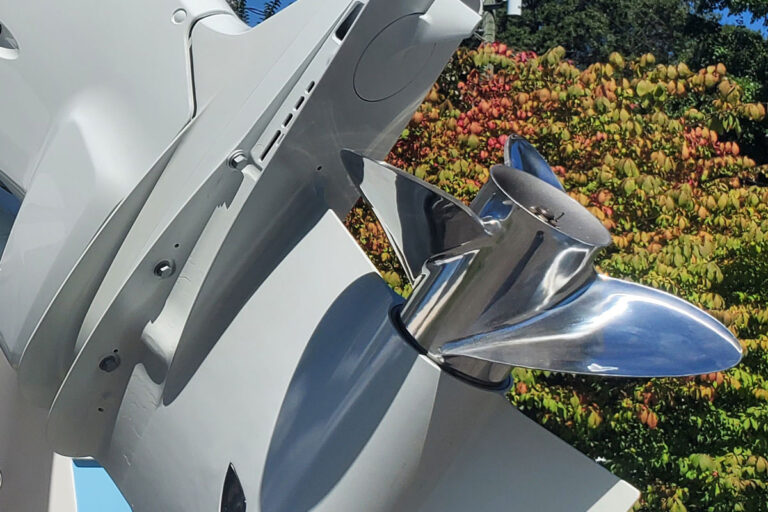Few would argue that engines are one of the most important components on any powerboat, no matter the mission. What’s surprising is that with the exception of some of the newer electronic engine packages offered by most engine manufacturers, many new boats do not come equipped with the proper gauges to more accurately monitor the engine’s vital signs. Aboard many boats delivered today, there is virtually no way to recognize early signs of trouble before a failure.
Thankfully, key companies such as VDO, Stewart-Warner, FloScan, Parker Industries and Teleflex-and a number of after-market companies-offer gauges that can help captains identify possible failures before they cause engine damage.
Here are a few worth considering for your helm.
Exhaust Pyrometer
Your standard engine water temperature gauge measures the temperature of water at the closed circuit cooling system. This is an acceptable practice and a beneficial piece of information, but by the time you hear the piercing shriek of a high temperature alarm on the exhaust riser, it is often too late. Unless you have been diligently monitoring the subtle increase in temperature, the alarm is often accompanied by the smell of smoke after the engine reaches a high temperature and needs to be shut down.
An exhaust pyrometer offers early warning by reading the exhaust gas temperature at the exhaust elbow stemming from the engine. This reading occurs just abaft the raw-water introduction to the exhaust riser, where the exhaust gas heats up.
An increase noted on the exhaust pyrometer gauge lets you decrease rpm, or shut down your engine and begin to troubleshoot by looking for a blockage in the raw-water system or for coolant leaks. Not only will this improve your cruise, but operating an engine within the optimal temperature setting will prolong the life of your diesel.
When selecting an exhaust pyrometer, you can order the gauge face to reflect the optimal operating temperature determined by your engine manufacturer. Depending upon your boat and engine package, exhaust pyrometers run between $200 and $800.
Boost Gauge
Like an exhaust pyrometer, a boost gauge will help prolong the life of your engine. It measures intake manifold boost pressure produced by the turbocharger. You’ll need to know the recommended cruising rpm of your diesel and the recommended boost PSI at that rpm to properly utilize this information.
A higher PSI can indicate an overloaded engine, which is one of the most important things to avoid if you want longevity in a marine diesel. In general, you want to operate at 70 percent load. The boost gauge will indicate where you are. A higher PSI at the recommended cruising speed can also indicate excess weight and a need to check the propeller pitch and diameter. Reducing the pitch and the load can also increase fuel efficiency.
If space at your boat’s helm is at a premium, several companies offer combination exhaust pyrometer/boost gauges. The cost ranges from $100 to $300.
Fuel Burn Gauges
Trying to measure fuel flow rate often involves voodoo magic and guesswork. Even on larger yachts, an element of suspicion is cast toward the typical electromagnetic fuel tank gauges that seem to bounce a quarter of a tank with every pitch of the boat. Furthermore, these gauges only measure the level of fuel, not its consumption. What you want is a gauge that can electronically measure gallons burned over time.
A yacht does not always have the same rate of fuel consumption at a given speed. Several factors can increase the rate of consumption, and a set of fuel flow gauges can highlight these factors while ensuring you don’t run out of fuel offshore.
For instance, a clogged fuel injector can increase the rate of fuel you burn. So can a fouled bottom. Left unchecked, the former symptom can develop into a burned valve or a piston failure-far more costly to repair than clearing your injectors after an early warning from a fuel flow gauge.
The sea state, the weather and the boat’s weight also affect the amount of fuel your boat will burn per hour. Figuring out this data also allows you to determine your boat’s optimum performance numbers. For instance, on a planing hull, operating at transitional speeds just prior to planing will increase fuel burn and indicate you need to trim the yacht. Likewise, a hull that is improperly trimmed at higher speeds will push water. A higher gallons-per-hour reading on your gauge will indicate you may need to trim the bow to reduce the amount of water being pushed.
Fuel burn gauge prices begin at $350 and can cost several thousand dollars more, depending on your needs.
Fuel Filter Gauges
Changing fuel filters is one of those jobs some of us put off. We often look long and hard at the site bowl of our secondary filter, convincing ourselves we see nothing but clear fuel.
For a bit more certainty, consider gauges that allow you to monitor the filters from your helm. Fuel contamination is one of the most frequent causes of engine failure, and a proper set of gauges will alert you when debris restricts the fuel flow between the filter and the engine-information that is good to have before you are trying to change and prime filters inside a hot engineroom and atop a foul sea.
A simple vacuum gauge will measure the vacuum inside the filter. These gauges are not only available as part of the bowl element, but can be installed at the helm. The principle is simple: An increased vacuum reading means there is a restriction in the filter. If you have a crossover system, you can change the filter with a turn of a knob (without shutting down the engine) until you have the time to mess around with changing the element of the clogged filter. If your boat is not equipped with this system, you’ll still have the opportunity to make the change before an engine failure.
Meanwhile, a water sensor with alarm will alert you to the presence of water in your fuel, letting you monitor your filters or drain them accordingly.
Fuel filter gauges range from $225 to $800, but as with all the others described above, can save you much more in the long run.









